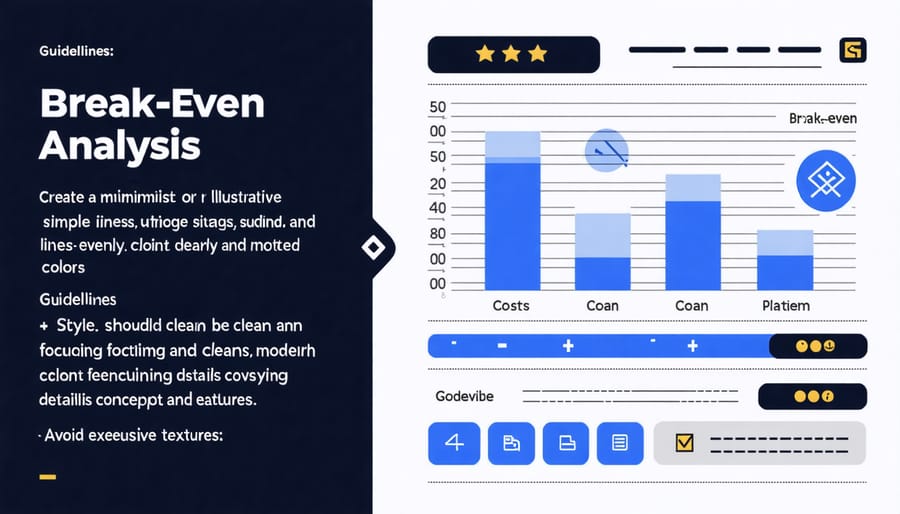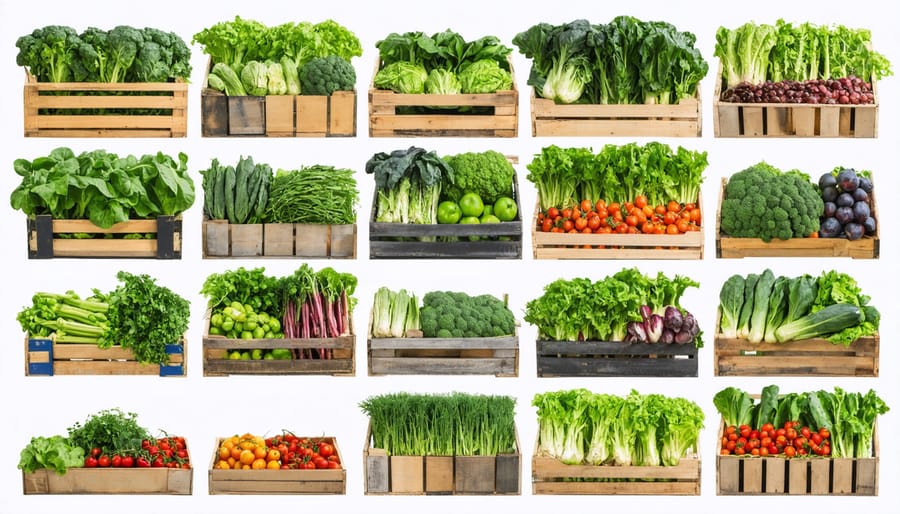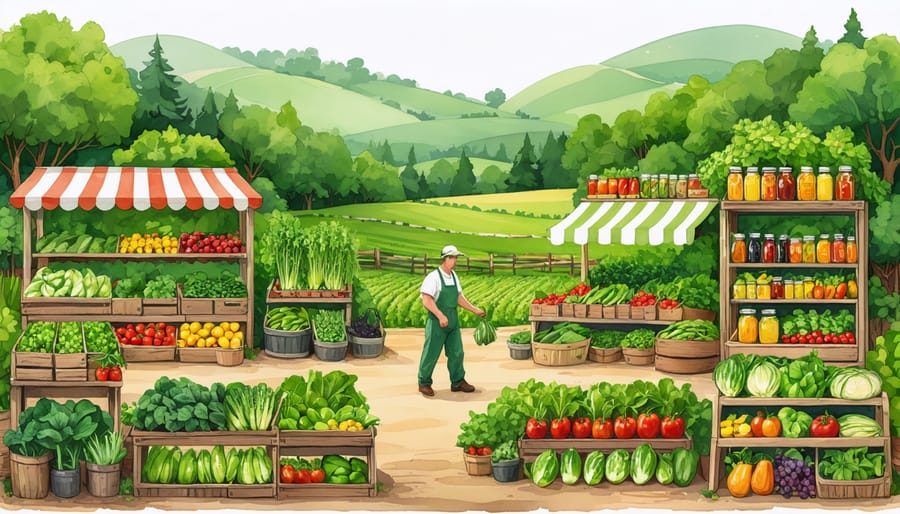Economic viability in farming demands a laser-focused approach to balancing costs, revenue, and sustainable growth. Like many successful CSA operations, profitability hinges on maximizing resource efficiency while meeting market demands. Calculate your break-even point by analyzing fixed costs, variable expenses, and projected sales volume before launching operations. Track key performance indicators including customer retention rates, crop yields, and profit margins per acre to measure financial health. Implement diverse revenue streams through value-added products, educational workshops, and strategic partnerships to create year-round income stability. Local food systems are evolving rapidly, making economic viability both challenging and achievable for farms that combine smart financial planning with innovative marketing approaches. Success requires treating your farm as both a mission-driven enterprise and a business that must generate sustainable profits to serve your community long-term.
Essential Components of CSA Economic Viability

Revenue Streams and Pricing Models
Successful CSA farms typically employ diverse CSA pricing strategies to maintain economic stability throughout the year. The most common model is the upfront seasonal payment, where members pay for their entire share before the growing season begins. This provides farmers with essential operating capital when they need it most for seeds, equipment, and labor costs.
Many farms now offer flexible payment plans, including monthly installments or sliding-scale options to make shares more accessible to different income levels. Some CSAs complement their core produce shares with add-on products like eggs, honey, or flowers, creating additional revenue streams.
Value-added products, such as preserved goods or ready-to-eat meals, can help maintain income during slower growing seasons. Farm events, workshops, and agritourism activities often provide supplementary income while building stronger community connections.
Successful CSAs typically price their shares to reflect both the true cost of production and the local market’s capacity, ensuring fair compensation for farmers while remaining competitive with other food sources.
Cost Management and Resource Allocation
Managing costs effectively is crucial for a successful CSA operation. Start by categorizing your expenses into fixed costs (like land lease, equipment, and infrastructure) and variable costs (such as seeds, labor, and utilities). Create a detailed budget that accounts for seasonal variations and unexpected expenses, maintaining a buffer of 10-15% for emergencies.
Resource allocation requires careful planning throughout the growing season. Implement systems to track labor hours, water usage, and material costs for each crop. This data helps identify which products provide the best return on investment and where adjustments might be needed. Many successful CSA farmers use scheduling tools and crop planning software to optimize resource distribution.
Consider creative cost-sharing arrangements with neighboring farms for expensive equipment or bulk supply purchases. Some farms reduce costs by involving members in harvest days or offering work-share programs. Regular analysis of your resource allocation helps identify areas where efficiency can be improved, such as implementing water-saving irrigation systems or investing in season-extension infrastructure that can increase crop yields and extend the growing season.
Remember that proper cost management often requires initial investment in quality tools and systems that will save money in the long run.
Measuring Your CSA’s Financial Health
Break-Even Analysis
Break-even analysis is a crucial tool that helps farmers determine exactly how much they need to produce and sell to cover their costs. To calculate your break-even point, start by listing all your fixed costs (like land lease, equipment, and insurance) and variable costs (such as seeds, water, and labor). Add these together to get your total costs.
Next, determine your average selling price per unit (whether that’s per CSA share, per pound of produce, or per box). Divide your total costs by the price per unit to find out how many units you need to sell to break even.
For example, if your total annual costs are $40,000 and you sell CSA shares for $500 each, you’ll need to sell 80 shares to break even. This simple calculation helps you set realistic production goals and pricing strategies.
To achieve your break-even point more quickly:
– Optimize your crop selection based on local demand
– Reduce waste through proper planning and storage
– Consider value-added products to increase revenue
– Build strong customer relationships to ensure consistent sales
– Track expenses meticulously to identify cost-saving opportunities
Remember that breaking even is just the starting point. Aim to exceed this threshold by at least 20% to build a sustainable profit margin and account for unexpected challenges like weather events or equipment repairs.

Profit Margins and Growth Indicators
Understanding your profit margins is crucial for determining economic viability in your farming operation. A healthy CSA farm typically aims for a gross profit margin of 40-50% on produce sales, though this can vary based on your specific circumstances and market conditions.
Key growth indicators to monitor include customer retention rates, subscription renewal percentages, and year-over-year revenue growth. Successful CSA farms often see customer retention rates of 60-70%, with some achieving even higher numbers through excellent service and quality produce.
Consider the story of Green Meadows Farm, which increased their profit margins from 30% to 45% by analyzing their most profitable crops and adjusting their growing plans accordingly. They focused on high-value crops like heirloom tomatoes and specialty greens, which their customers were willing to pay premium prices for.
To track your farm’s economic viability, maintain detailed records of:
– Cost per share vs. revenue per share
– Labor costs as a percentage of revenue
– Seed and supply expenses
– Equipment maintenance costs
– Marketing expenses
Look for steady improvement in these metrics over time. A sustainable operation should see gradual increases in efficiency and profitability. Many successful farms find that diversifying income streams through value-added products or educational programs can help stabilize revenue and improve overall economic viability.
Strategies for Enhancing Economic Viability
Diversification Opportunities
One of the most effective ways to enhance economic viability is through strategic diversification of revenue streams. Successful CSA farms often complement their core subscription model with additional income-generating activities. On-farm events like harvest festivals, cooking classes, and educational workshops can create memorable experiences while generating extra revenue. Many farmers have found success by offering value-added products such as homemade jams, pickles, or dried herbs using excess produce.
Market expansion opportunities include partnering with local restaurants, schools, and food cooperatives. These relationships can provide stable bulk sales channels alongside regular CSA memberships. Some farms have successfully integrated agritourism activities, offering farm stays or guided tours that appeal to urban visitors seeking authentic agricultural experiences.
Take Sarah’s Fresh Farm as an example. What started as a traditional CSA operation now includes a popular farm-to-table dinner series, preserving workshops, and a small farm store. These additions have increased their annual revenue by 40% while creating deeper connections with their community.
E-commerce presents another avenue for growth, with many farms now offering online ordering systems and home delivery services. This digital presence can help reach younger, tech-savvy customers who value convenience alongside quality. Some farmers have even found success through social media channels, selling specialty items or exclusive seasonal offerings to their followers.
Remember that diversification should align with your farm’s core values and operational capacity. Start small with one or two additional revenue streams, and expand based on customer feedback and market demand. The key is finding the right balance between maintaining quality CSA service and exploring new opportunities for growth.

Efficiency Improvements
Maximizing efficiency is crucial for maintaining economic viability in CSA farming operations. Through implementing smart resource optimization techniques, farmers can significantly reduce operational costs while maintaining high-quality produce delivery.
One effective approach is adopting season extension methods like row covers and high tunnels, which allow farms to extend their growing season and maximize land usage. This means more harvests per year and steady income flow even during traditionally off-peak periods.
Time management improvements, such as streamlined harvest schedules and efficient packing systems, can reduce labor costs while ensuring fresh delivery to CSA members. Many successful farms have implemented mobile washing stations and sorting systems that cut processing time by up to 40%.
Energy efficiency plays a crucial role too. Installing solar panels for irrigation systems, using gravity-fed water distribution, and implementing drip irrigation can substantially reduce utility costs. Some CSA farms report saving up to 30% on water usage through these methods.
Equipment sharing among neighboring farms has become increasingly popular, helping reduce individual farm investment costs. For example, the Thompson Valley Farm Collective saved each participating farm an average of $5,000 annually by sharing specialized harvesting equipment.
Storage optimization is another key factor. Using root cellars and proper storage techniques can extend produce shelf life and reduce waste, directly impacting the bottom line. Modern inventory management systems help track produce movement and prevent overproduction, ensuring resources are used efficiently throughout the season.
Economic viability in farming is more than just calculating profits and losses – it’s about creating a sustainable business model that supports both your agricultural dreams and financial needs. By focusing on diverse revenue streams, efficient resource management, and strong community relationships, you can build a thriving CSA operation that stands the test of time.
Remember to start small and scale gradually, keeping detailed records of your costs and income along the way. Consider implementing value-added products, hosting farm events, or offering educational workshops to supplement your CSA income. Stay connected with your members through regular communication and feedback sessions to ensure you’re meeting their needs while maintaining profitable pricing structures.
Success stories from established CSA farmers show that economic viability is achievable with careful planning and adaptation. Take the first step by creating a detailed business plan, reaching out to local farming networks for guidance, and exploring available grants or funding opportunities. With dedication to sustainable practices and smart business management, your farming venture can become both environmentally and economically sustainable.
The journey to economic viability is ongoing – keep learning, adapting, and growing alongside your crops.

